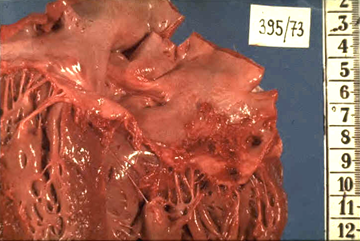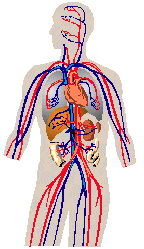| Are
My Bad Teeth Killing Me? - Robert O. Nara, D.D.S. |
|
|
STUDY links bad teeth, gums to heart disease Evansville Courier & Press - Evansville, IN, United States 2/22/04 ... Smith relates that gum disease produces bacteria that releases endotoxins which get in the blood stream and can attack the heart muscles. By gum, your life is in danger The Times (subscription) - London,England,UK 2/21/04 ... The Heidelberg University study of 300 stroke patients found they had four times as much gum disease as the rest of the population. GUM Disease Linked to Heart Disease & Stroke; You Need More than ... U.S. Newswire (press release) - Washington,DC,USA 2/17/04 ... Oral Health Fact Number 1: Periodontal (gum) disease has been linked to heat disease, stroke and respiratory disease in medical studies-and 80 percent of ... GUM disease and stroke link Medical News Today - UK 2/17/04 A study published in Stroke examined whether periodontal disease, is independently associated with cerebral ischaemia... HEART disease associated with oral health – studies of women ... Innovations-Report - Germany 2/20/04 ... A group of 187 female patients with CHD had fewer remaining teeth (P<0.001) and more pathological periodontal pockets (P=0.002) compared to a control group. ... DENTAL Disease can cause High Risk of Heart Problem Pakistan Times - Pakistan 2/04 PEOPLE with periodontal diseases or with few or no teeth experience elevate risk of cardiovascular diseases. A recent research has ...  |
(See also 'Current
News Articles' sidebar) Can you glance up
from this article and see another person?
Okay: As you read on, you might keep in mind that one of you two will probably die of heart disease. In fact, the national average is slightly higher than one out of two. Oh --You already knew that...? Did you also know that many of those deaths were from a heart disease brought on by bad oral health; and sometimes by dental treatment?
Suppose a person has this pre-disposition to bacterial endocarditis --where do the bacteria come from? How do they get from "outside" all the way to the interior of the heart?
Bacteria
enter the body through a failure of natural defensive barriers. One
such barrier is skin. Another is the In
order to survive once they invade, germs must have --or adopt --certain
characteristics:
The only oxygen in the blood is wrapped up inside red corpuscles. An "aerobic" germ would simply suffocate, just as we would, in the absence of oxygen:, an anaerobic microbe is at home in an oxygen-free environment. Is there anyplace on the outside of the body where such bacteria can survive? And, if we find such a place where anaerobic germs can thrive outside the barrier tissues --what is the condition of those tissues? If there are dangerous microbes lying in ambush outside the gates --how strong are the gates? There is one part of the human body which is consistently at or near internal body temperature, is rich in microscopic nourishment. is extremely moist and slightly saline, and is anaerobic. It is also on the outside of a barrier surface. In fact, if the bacteria were allowed to design a perfect place to lie in ambush, they probably couldn't create a better site: From the viewpoint of such germs, it is the perfect environment. This site is found at the base of nearly all human teeth; in the area between the tooth and gum surface. it is not a danger zone if oral health is disease-free... but please don't breathe a sigh of relief just yet. If you are one of millions of Americans who assume your oral health is safe, think about what Dr. Charles C. Bass' had to say in the American Heart Journal. "Bacteria in the periodontal pocket and in diseased periodontal tissues are the source of almost all bacteremia from the environment of the teeth. Periodontoclasia (pyorrhea) is a universal disease of man, originating as gingivitis in childhood, continuously advancing during adulthood, and never ending so long as any teeth remain. With the exception of those few persons who have learned and continuously follow the only entirely effective method of personal hygiene ever known, every dentulous (with teeth) adult now has demonstrable, active, advancing periodontoclasia lesions in some stage about most or all of his or her teeth. This includes all heart patients and, incidentally also, all dentulous cardiologists..." We would add only one thought to Dr. Bass' remarks: This includes you...and your dentist. Should you be concerned about the condition of your teeth and gums? Let's return to Dr. Bass, in the same article: "Prevention of these dental diseases should also prevent those diseases of the heart in which the infection comes from such foci. Under these circumstances, the health welfare, and even life itself, of persons who have heart conditions which predispose to infection may depend upon prevention and control of dental disease." What
is a periodontal pocket? And, more than that, how do I know whether I
have any? How do I get rid of them? The normal "gap" between the base of a tooth and the adjacent healthy gum tissue is about two millimeters deep; about one-sixteenth of an inch. Bacteria lodge in this tiny "trench" (called the gingival crevice) and begin to multiply and produce toxins--poisons. Through a well-understood mechanism, this causes the crevice to deepen, ultimately forming the "pocket." It is normal to have pockets without knowing it. Such pockets are festering cesspools of mixed bacteria, with one important thing in common: They are anaerobic. There is no atmospheric oxygen in a periodontal pocket. The gum tissue, when healthy, is a germ barrier. When infected--when its one-cell-thickness is pierced by anything--it can no longer act as a barrier. Bacteria can then enter the blood circulatory system almost at will. When they do, the victim has bacteremia. If he or she also has a heart defect which predisposes to bacterial infection, that person may be in deep trouble. The only known method of counter-acting periodontal disease is a very specific hygiene method. Periodontal surgery, often performed when the disease damage has become severe, may relieve symptoms and retard the disease progress; but surgery does not cure the disease itself. Oramedics International has numerous brochures on this and it is covered in detail in the book How To Become Dentally Self-Sufficient. A special tip which works on any WaterPik oral irrigator has been designed by Oramedics specifically to combat periodontal disease. (Note: WaterPik no longer supplies this cannula tip for their irrigators. Please view the ViaJet Pro page for this attachment.) Even if you don't have (or don't think you have) heart damage, eliminating periodontal disease is the only sure method of keeping your teeth and enjoying better overall health. If
you have a heart problem, understanding periodontal disease is just
as Dr. Bass said it: "...the health welfare, and even life itself, of
persons who have heart conditions...may depend upon prevention of
dental disease." What Can You Do? Subscribe to the OraMedia Newsletter for Dental Self Sufficiency |
 The
disease is called
The
disease is called  First,
let's look at how bacteria reach the heart once they do get into the
interior: They simply "hitch-hike" through the body's freeway system;
the bloodstream. Doctors call this unauthorized use of the circulatory
system bacteremia.
An "--emia" is simply an excess of anything in the blood. Since there
should never be any of these germs inside the body, enough to cause
trouble is definitely an "excess;" it is bacteremia.
First,
let's look at how bacteria reach the heart once they do get into the
interior: They simply "hitch-hike" through the body's freeway system;
the bloodstream. Doctors call this unauthorized use of the circulatory
system bacteremia.
An "--emia" is simply an excess of anything in the blood. Since there
should never be any of these germs inside the body, enough to cause
trouble is definitely an "excess;" it is bacteremia.  tooth structure. These surfaces
are not, themselves, vulnerable to germs; and they prevent germs from
access to inner tissues
which have no natural immunity, no defense.
tooth structure. These surfaces
are not, themselves, vulnerable to germs; and they prevent germs from
access to inner tissues
which have no natural immunity, no defense. 